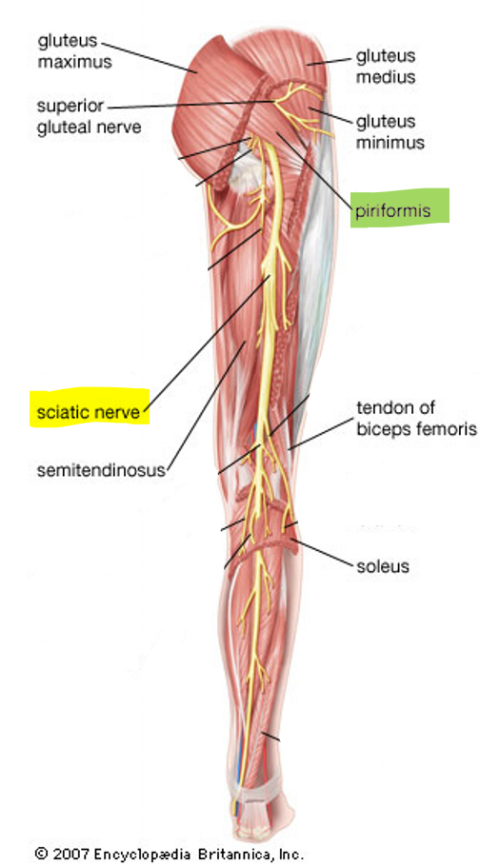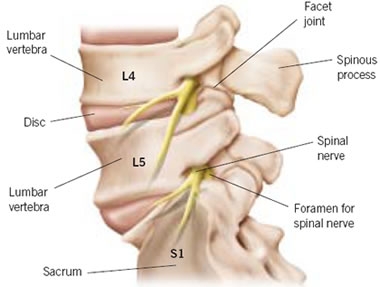Sciatica is a common term that many people have heard. Low back and leg pain? Oh yeah, that’s just sciatica. Discomfort after driving for a long time? Oh that’s that sciatica acting up again. Sciatica has turned into a catch all phrase that’s casually thrown around. But what exactly is sciatica? What causes that irritating pain?
Definition and Causes of Sciatica
Sciatica is simply pain and tenderness at some point(s) along the sciatic nerve. Check out the image below of the sciatic nerve. (This anatomy picture is looking at the back side of a right leg. The sciatic nerve is shown coming out from under the piriformis muscle down to the back part of the knee.)
There is a lot going on around the sciatic nerve. The pain can be caused by irritation of any part of the nerve.
Below is a picture of a healthy spine and nerve roots leaving your spinal cord. You can have irritation of the sciatic nerve starting here! The sciatic nerve is made up of nerve branches from the spinal cord from the L4 level to the S3 level. If any of the discs in this area bulge or herniate (where the inside material of the disc is pushed outwards), they can irritate the nerves exiting the spinal cord. If you have degenerative joint disease (DJD), the amount of space for the exiting nerve (aka the foramen for spinal nerve) decreases in size. The smaller space for the nerves to exit the spinal cord can lead to increases in nerve iritation.
The pain can also be caused from irritation of the nerve as it travels through/in/around any of the muscles. A common site of irritation can be from the piriformis muscle. In most people the muscle passes underneath the muscle (as seen in the first anatomy pic), but in some people, the nerve travels through or around the muscle. The piriformis muscle is important muscle used in walking and stabilizing the hips and pelvis. If the piriformis muscle gets tight, it can lead to irritation of the sciatic nerve. The nerve also travels along the hamstrings (which are actually 3 muscles--semimembranosus, semitendinosus, and biceps femoris). Strain on these muscles can also cause sciatic symptoms.
Signs and Symptoms
Sciatica presents with increased pain and or paresthesia along the back part of the leg to the knee or even all the way down into your foot. This can lead to an altered walking pattern, which can cause even MORE pain. Pain can increase while bending forward like if you were going to touch your toes/tie your shoes/etc. Patients with sciatica can also notice pain in the back of the knee or in the gluteal area, especially when palpated.
Chiropractic Approach
First off, a chiropractic exam is performed to determine the cause of the sciatica. A series of orthopedic tests, neurological tests, and palpation of the muscles and joints give us a good understanding of what is causing your pain. Through this exam, we can usually identify what the cause(s) of the pain are. The cause of the sciatica dictates the treatment.
If there is disc irritation from DJD, the patient is usually treated with flexion and distraction. If there is muscle inflammation or strain causing the problem, we will perform muscle release techniques, electrical stimulation, or various other modalities to help relieve the inflammation, relax the muscles, and take pressure off of the nerve. Some patients may have multiple causes contributing to their sciatica, so we treat all the causes. We are also a big fan of home stretches to help eliminate future flair ups. After your first treatment, we will go through those exercises and make sure that you are comfortable with your home care stretches.
There is no need to live with insistent, irritating low back and leg pain. Call us today!


